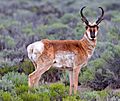List of mammals of the United States facts for kids
The United States is home to about 490 different kinds of mammals. This list focuses on mammals found in the main US states. It includes animals that were brought here by people, and some that have become extinct recently.
Scientists and conservation groups keep track of how many of these animals are doing well. They use special terms to describe if a species is in danger.
- Critically Endangered: These animals are in very high danger of disappearing forever in the wild.
- Endangered: These animals face a high risk of becoming extinct in the wild.
- Vulnerable: These animals are facing a high risk of extinction in the wild.
- Near Threatened: These animals are not currently in danger, but they might be in the future.
- Least Concern: These animals are doing well and are not currently at risk.
- Data Deficient: We don't have enough information to know if these animals are in danger.
- Extinct: The last animal of this kind has died.
- Extinct in the Wild: These animals only live in zoos or special protected areas, not in nature.
The US government also has its own list called the Endangered Species Act. It uses these terms:
- E means Endangered.
- T means Threatened. This means they are likely to become endangered soon.
- XN or XE means an eXperimental Nonessential or Essential population. This is for groups of animals being reintroduced.
- E(S/A) or T(S/A) means Endangered or Threatened due to Similarity of Appearance. This is for animals that look like endangered ones.
Some animals on this list are marked with special letters:
- (A) - Accidental: They are usually found elsewhere but sometimes show up in the US.
- (E) - Extinct: They no longer exist anywhere.
- (Ex) - Extirpated: They are gone from the US but still live in other parts of the world.
- (I) - Introduced: They were brought to the US by people.
Contents
Mammals with Pouches (Metatheria)
These mammals are known for carrying their young in a pouch.
Opossums (Didelphimorphia)
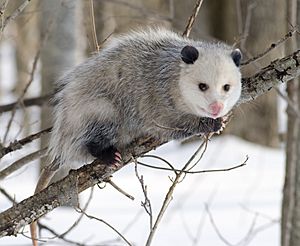
Opossums are small to medium-sized mammals. They have a long snout and a tail that can grip things. They are the only marsupials (mammals with pouches) found in North America.
- Family: Didelphidae (American opossums)
- Virginia opossum, D. virginiana
Placental Mammals (Eutheria)
These mammals develop their young inside the mother's body, connected by a placenta.
Armadillos (Cingulata)
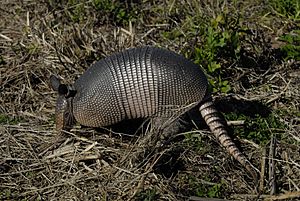
Armadillos are small mammals with a unique bony shell. They are native to the Americas. In the United States, you'll mostly find the nine-banded armadillo.
- Family: Dasypodidae (armadillos)
- Nine-banded armadillo, D. novemcinctus
Rodents (Rodentia)
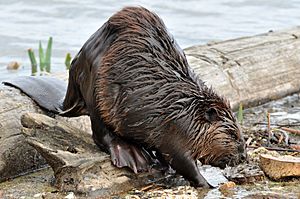
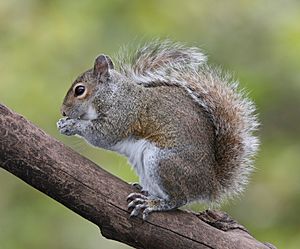
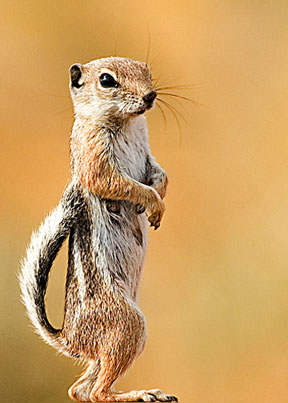
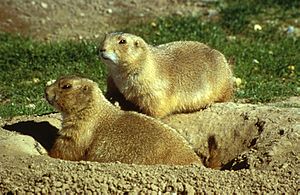
Rodents are the largest group of mammals. They make up over 40% of all mammal species. They have two front teeth in their upper and lower jaws that never stop growing. They must keep these teeth short by gnawing on things.
- Family: Erethizontidae (New World porcupines)
- North American porcupine, E. dorsatum
- Family: Castoridae (beavers)
- American beaver, C. canadensis
- Family: Sciuridae (squirrels)
- Northern flying squirrel, G. sabrinus
- Southern flying squirrel, G. volans
- Eastern gray squirrel, S. carolinensis
- Fox squirrel, S. niger
- American red squirrel, T. hudsonicus
- White-tailed antelope squirrel, A. leucurus
- Black-tailed prairie dog, C. ludovicianus
- Yellow-bellied marmot, M. flaviventris
- Eastern chipmunk, T. striatus
- Family: Geomyidae (pocket gophers)
- Northern pocket gopher, T. talpoides
- Family: Heteromyidae (kangaroo rats and pocket mice)
- Ord's kangaroo rat, D. ordii
- White-footed mouse, P. leucopus
- Family: Cricetidae (voles, lemmings, mice, rats)
- Singing vole, M. miurus
- Muskrat, O. zibethicus
- Hispid cotton rat, S. hispidus
Lagomorphs (Lagomorpha)
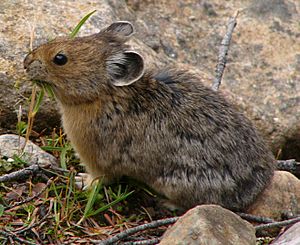
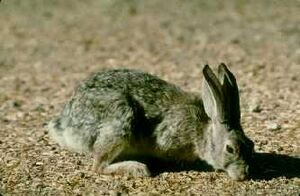
Lagomorphs include hares, rabbits, and pikas. They look a bit like rodents, but they are a separate group. One key difference is that they have four front teeth in their upper jaw, not two.
- Family: Ochotonidae (pikas)
- American pika, O. princeps
- Family: Leporidae (rabbits, hares)
- Pygmy rabbit, B. idahoensis
- Snowshoe hare, L. americanus
- Black-tailed jackrabbit, L. californicus
- Desert cottontail, S. audubonii
- Eastern cottontail, S. floridanus
Shrews, Moles, and Hedgehogs (Eulipotyphla)

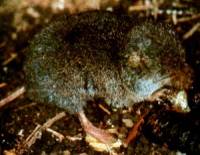
This group includes small, insect-eating mammals. Shrews look like tiny mice, while moles are strong burrowers.
- Family: Soricidae (shrews)
- Northern short-tailed shrew, B. brevicauda
- American pygmy shrew, S. hoyi
- Marsh shrew, S. bendirii
- Smoky shrew, S. fumeus
- American water shrew, S. palustris
- Family: Talpidae (moles)
- Star-nosed mole, C. cristata
- Eastern mole, S. aquaticus
- Shrew-mole, N. gibbsii
Bats (Chiroptera)
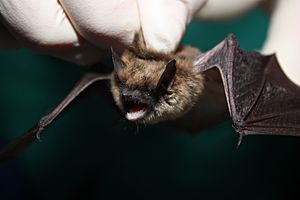
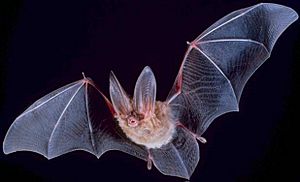
Bats are the only mammals that can truly fly! Their front limbs have developed into wings. Bats make up about 20% of all mammal species in the world.
- Family: Vespertilionidae (common bats)
- Little brown bat, M. lucifugus
- Gray bat, M. grisescens E
- Indiana bat, M. sodalis E
- Big brown bat, E. fuscus
- Eastern red bat, L. borealis
- Hoary bat, A. cinereus
- Townsend's big-eared bat, P. townsendii
- Family: Molossidae (free-tailed bats)
- Mexican free-tailed bat, T. brasiliensis
- Western mastiff bat, E. perotis
- Family: Mormoopidae (leaf-chinned bats)
- Ghost-faced bat, M. megalophylla
- Family: Phyllostomidae (leaf-nosed bats)
- California leaf-nosed bat, M. californicus
- Lesser long-nosed bat, L. yerbabuenae E
Carnivores (Carnivora)
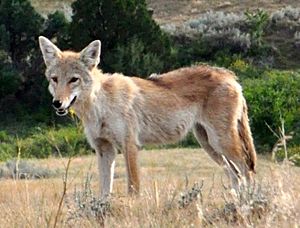
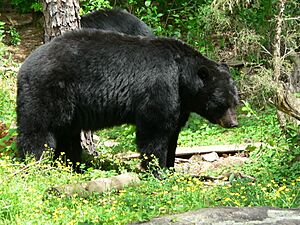
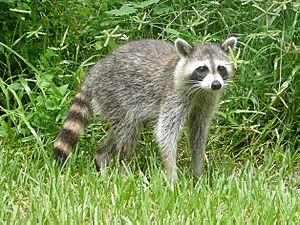
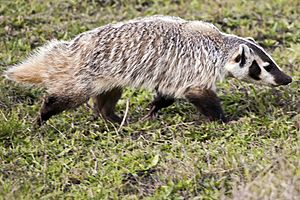
Carnivores are mammals that mostly eat meat. They have special teeth and skull shapes for hunting and eating prey.
- Family: Felidae (cats)
- Ocelot, L. pardalis E
- Canada lynx, L. canadensis T
- Bobcat, L. rufus
- Cougar, P. concolor
- Family: Canidae (dogs)
- Family: Ursidae (bears)
- American black bear, U. americanus
- Brown bear (including Grizzly bear), U. arctos T
- Polar bear, U. maritimus T
- Family: Procyonidae (raccoons)
- Ring-tailed cat, B. astutus
- Raccoon, P. lotor
- Family: Mustelidae (weasels, otters, badgers)
- Sea otter, E. lutris T
- Wolverine, G. gulo
- North American river otter, L. canadensis
- Black-footed ferret, M. nigripes E
- American badger, T. taxus
- Family: Otariidae (eared seals, sea lions)
- California sea lion, Z. californianus
- Steller sea lion, E. jubatus T
- Family: Mephitidae (skunks)
- Striped skunk, M. mephitis
- Family: Odobenidae (walruses)
- Walrus, O. rosmarus
- Family: Phocidae (earless seals)
- Hawaiian monk seal, N. schauinslandi E
- Harbor seal, P. vitulina
Even-Toed Hoofed Mammals (Artiodactyla)
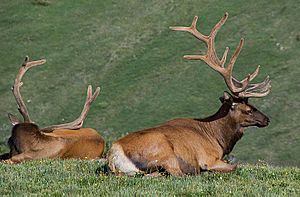
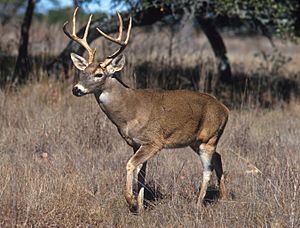
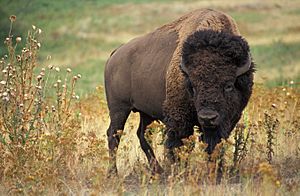
This group includes animals like deer, bison, and sheep. Their weight is supported equally by their third and fourth toes. Many of these animals are important to humans.
- Family: Tayassuidae (peccaries)
- Collared peccary, D. tajacu
- Family: Cervidae (deer)
- Elk, C. canadensis
- Moose, A. alces
- Mule deer, O. hemionus
- White-tailed deer, O. virginianus
- Caribou, R. tarandus
- Family: Antilocapridae (pronghorn)
- Pronghorn, A. americana
- Family: Bovidae (cattle, antelope, sheep, goats)
- American bison, B. bison T
- Mountain goat, O. americanus
- Bighorn sheep, O. canadensis
- Dall sheep, O. dalli
Manatees and Dugongs (Sirenia)
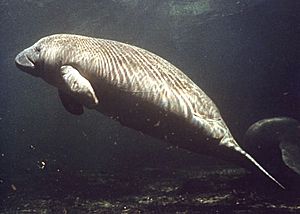
Sirenia are fully aquatic, plant-eating mammals. They live in rivers, coastal waters, and wetlands. They are often called "sea cows."
- Family: Trichechidae
- West Indian manatee, T. manatus E
Whales, Dolphins, and Porpoises (Cetacea)
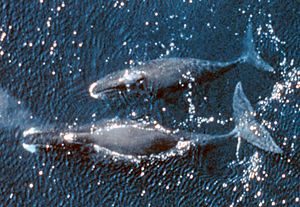
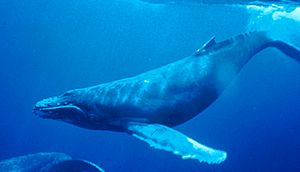
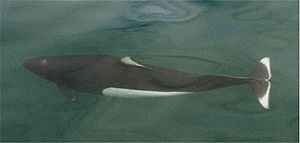
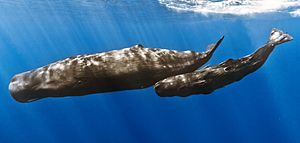
This group includes all whales, dolphins, and porpoises. They are mammals that are completely adapted to life in the water. They have streamlined bodies, very little hair, and flippers for swimming.
- Family: Balaenidae (right whales)
- Bowhead whale, B. mysticetus
- North Atlantic right whale, E. glacialis E
- Family: Balaenopteridae (rorquals)
- Sei whale, B. borealis E
- Blue whale, B. musculus E
- Fin whale, B. physalus E
- Humpback whale, M. novaeangliae E
- Gray whale, E. robustus E
- Family: Monodontidae (narwhal and beluga)
- Beluga, D. leucas E
- Family: Phocoenidae (porpoises)
- Dall's porpoise, P. dalli
- Family: Physeteridae (sperm whales)
- Sperm whale, P. macrocephalus E
- Family: Kogiidae (dwarf and pygmy sperm whales)
- Pygmy sperm whale, K. breviceps
- Family: Ziphiidae (beaked whales)
- Cuvier's beaked whale, Z. cavirostris
- Family: Delphinidae (marine dolphins)
- Short-beaked common dolphin, D. delphis
- Killer whale, O. orca E
- Striped dolphin, S. coeruleoalba
- Common bottlenose dolphin, T. truncatus
Introduced Animals
These are mammals that were brought to the United States by humans, either on purpose or by accident. They are not native to the area.
- Family: Echimyidae
- Coypu, M. coypus (I)
- Family: Sciuridae (squirrels)
- Mexican gray squirrel, S. aureogaster (I)
- Family: Muridae (mice, rats)
- House mouse, M. musculus (I)
- Brown rat, R. norvegicus (I)
- Family: Leporidae (rabbits, hares)
- European rabbit, O. cuniculus (I)
- Family: Cercopithecidae (Old World monkeys)
- Japanese macaque, M. fuscata (I) T
- Rhesus monkey, M. mulatta (I)
- Family: Herpestidae (mongoose)
- Small Indian mongoose U. auropunctata (I)
- Family: Suidae (pigs)
- Wild boar, S. scrofa (I)
- Family: Cervidae (deer)
- Sika, C. nippon (I)
- Family: Bovidae (cattle, antelope, sheep, goats)
- Nilgai, B. tragocamelus (I)
- Family: Equidae (horses)
- Domestic horse, E. f. caballus (I)
Images for kids
See also
- List of mammals of Canada
- List of mammals of North America
- List of threatened mammals of the United States
- List of chordate orders
- Lists of mammals by region
- Mammal classification









